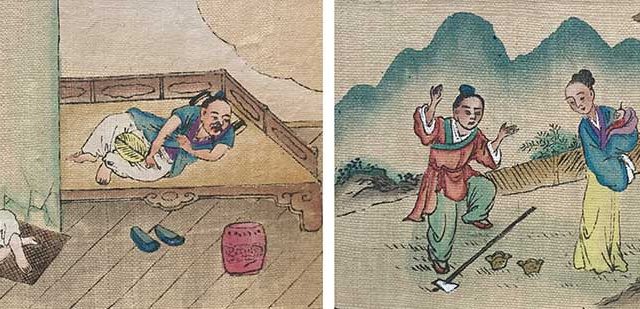Walpurgisnacht, also known as Walpurgis Night, Saint Walpurgis Night and Saint Walpurga’s Eve, is a celebration that takes place every year on the night of April 30 and into the early morning of May 1. Originally, this was the night before the feast day of Saint Walpurga, which commemorates her canonization and the transfer of her relics to the town of Eichstätt, Germany on 1 May 870. However, the eve of this Christian celebration became synonymous with witches, who were believed to gather on that night on Brocken Mountain, the tallest peak in the Harz Mountains in Northern Germany, to conduct wild rituals and engage in congress with the Devil.
Walpurga was an Anglo-Saxon missionary to the Frankish Empire who lived in the 8th century. Born into a noble family, she was the daughter of Richard the Pilgrim and Wuna of Essex, both revered as saints of noble origin. Walpurga traveled with her brothers to Francia to evangelize the still-pagan Germans and convert them to Christianity. Later, she became a nun at the monastery of Heidenheim am Hahnenkamm, founded by her brother Willibald, where she succeeded him as abbess. After her death, Walpurga’s bones were transferred to Eichstätt and placed in a rocky niche, which was said to miraculously exude a therapeutic oil. This so-called ‘Walpurgis oil,’ believed to originate from her bones, attracted pilgrims to her shrine and was reputed to be highly effective against disease.


Saint Walpurga was hailed by the Christians of Germany for battling pests, rabies, and whooping cough, as well as witchcraft. As invoking the Saint was believed to be powerful against evil magic, Medieval and Renaissance traditions held Walpurgis Night at the same time as witches celebrated their Sabbath and evil forces were at their peak. According to German folklore, Walpurgis Night marked the witches’ gathering on the Brocken.

To ward off malevolent spirits and protect their livestock, people traditionally lit fires on the hillsides, a practice that still persists in some regions today. In Bavaria, southeast Germany, the feast day is also known as Hexennacht, or “Witches’ Night.” Revelers embrace the occasion by dressing as witches and demons, setting off fireworks, dancing, and playing loud music—a joyous spectacle said to drive away both witches and the lingering spirits of winter. It is suggested that Walpurgis Night is linked with older May Day festivals in northern Europe, which also involved lighting bonfires, such as the Gaelic festival Beltane.

But what exactly is the Witches’ Sabbath?
The concept of witchcraft began to take shape in the early 15th century in the western Alps, influenced by evolving ideologies and judicial practices that paved the way to the great European witch-hunts of the following centuries. Though rooted in longstanding beliefs about harmful magic in European culture, it was during the late Middle Ages and the early modern period that common magic and sorcery evolved into the crime of witchcraft and the image of the magician gradually transformed into this of the satanic witch.
The first to condemn witchcraft were theologians, inquisitors, and magistrates, convinced of a satanic sect’s existence. Early on, witchcraft was likened to heresy, with witches often being called heretici in texts. This association would justify ecclesiastical courts treating it as a crime against faith. Much like heretics, witches were thought to work in groups and meet in secrecy, sparking anxiety over their gatherings’ unknown locations and activities. Responding to the Church’s fears, authors shaped the concept of the witches’ Sabbath—a nocturnal gathering where various diabolical acts were believed to occur.
Witches, who were originally both male and female, were believed to form sects, renounce the Christian faith and worship the Devil, pledging their submission through a pact. When summoned, witches would secretly gather to pay the Devil homage, often traveling by flying on brooms, sticks, animals, or being carried there by demons. At these gatherings, they would participate in multiple rituals, festivities, acts against nature, cannibalistic acts, sexual orgies (even sexual acts with demons), while they would also plot ways to inflict harm on people, animals, and crops. Such sects were seen as a grave societal threat, prompting efforts to raise awareness and combat this new terror.

The idea of Sabbath introduced key symbols of witchcraft that remain well-known today. Early beliefs included the idea of bloodsucking witches that abduct, kill, and often eat, infants, as well as one of the most lasting images, the witch with a cauldron, that dates as far back as the sixth century. Women were often imagined brewing love potions, medicines, potions that could make a man impotent or even hailstorms. Another central idea was the night flight and by the mid-15th century, witches were frequently depicted flying to the Sabbath.

It was also during the first decades of the 15th century that we find the explicit association of witchcraft with the female sex. It was then introduced not simply that women were more prone to witchcraft, rather that harmful magic was coming exclusively from them. The new stereotype of the satanic, female witch spread through visual images, that depicted the reality of witchcraft and started circulating in illustrated print publications or even being distributed independently.

The concept of the witches’ Sabbath has endured for centuries, its vivid imagery becoming deeply ingrained in cultural depictions of witchcraft. From ancient fears of bloodsucking witches to iconic symbols like cauldrons and witches riding brooms, the Sabbath remains a captivating and recognizable element in art, literature, and folklore, shaping our perceptions of witchcraft to this day.



